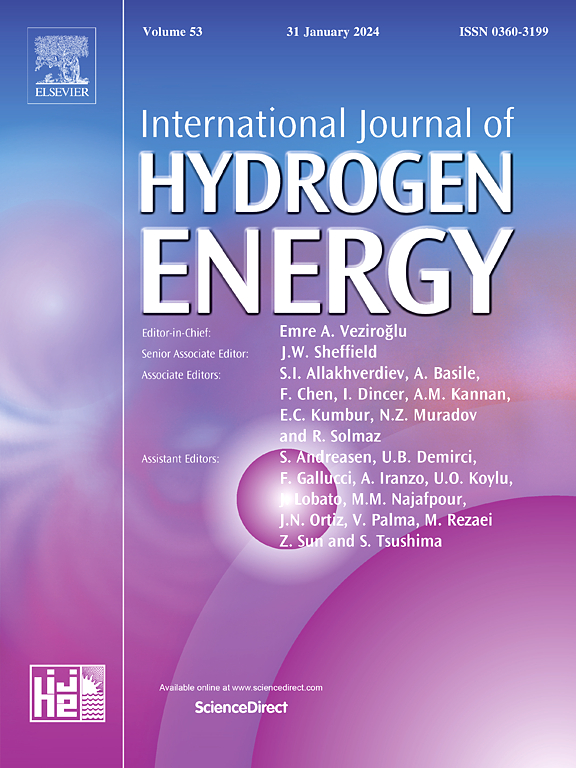FeCo nanoalloy embedded in N-doped carbon aerogel as high-efficiency oxygen electrocatalyst for long-term zinc-air batteries
IF 8.1
2区 工程技术
Q1 CHEMISTRY, PHYSICAL
引用次数: 0
Abstract
Bifunctional oxygen electrocatalysts with low cost and high catalytic activity are critically important for improving the energy conversion efficiency of metal-air batteries. In this work, a novel electrocatalyst, denoted as NC-FexCoy, was synthesized via the growth of Fe-ZIF-67 on the surface of a chitosan-derived aerogel, followed by subsequent annealing treatment. The adjustable pore structure of the chitosan-derived carbon aerogel facilitates enhanced availability of active sites. Moreover, the synergistic interplay between the FeCo nanoalloy and the nitrogen-doped carbon framework further augments its catalytic performance. As expected, the optimized catalyst NC-Fe1Co3 exhibits exceptional bifunctional electrocatalytic activity, achieving a half-wave potential of 0.88 V for the oxygen reduction reaction (ORR) and an overpotential of only 378 mV for the oxygen evolution reaction (OER). Furthermore, the assembled liquid ZABs employing the NC-Fe1Co3 as air cathode demonstrated outstanding performance, delivering a remarkable power density of 240 mW cm−2 and long-time charge-discharge stability over 2000 h. Additionally, the flexible ZABs fabricated with this catalyst achieved an even higher power density of 116 mW cm−2, coupled with a robust cycle stability lasting over 200 h.

n掺杂碳气凝胶包埋FeCo纳米合金作为长效锌空气电池的高效氧电催化剂
低成本、高催化活性的双功能氧电催化剂对提高金属-空气电池的能量转换效率具有重要意义。在这项工作中,通过在壳聚糖衍生的气凝胶表面生长Fe-ZIF-67,然后进行退火处理,合成了一种新型电催化剂NC-FexCoy。壳聚糖衍生碳气凝胶的可调节孔隙结构有助于提高活性位点的可用性。此外,FeCo纳米合金与氮掺杂碳骨架之间的协同作用进一步增强了其催化性能。正如预期的那样,优化后的催化剂NC-Fe1Co3表现出优异的双功能电催化活性,氧还原反应(ORR)的半波电位为0.88 V,析氧反应(OER)的过电位仅为378 mV。此外,采用NC-Fe1Co3作为空气阴极的组装液体ZABs表现出出色的性能,提供了240 mW cm - 2的显着功率密度和超过2000 h的长时间充放电稳定性。此外,用该催化剂制造的柔性ZABs实现了更高的功率密度,达到116 mW cm - 2,并具有持续超过200 h的强大循环稳定性。
本文章由计算机程序翻译,如有差异,请以英文原文为准。
求助全文
约1分钟内获得全文
求助全文
来源期刊

International Journal of Hydrogen Energy
工程技术-环境科学
CiteScore
13.50
自引率
25.00%
发文量
3502
审稿时长
60 days
期刊介绍:
The objective of the International Journal of Hydrogen Energy is to facilitate the exchange of new ideas, technological advancements, and research findings in the field of Hydrogen Energy among scientists and engineers worldwide. This journal showcases original research, both analytical and experimental, covering various aspects of Hydrogen Energy. These include production, storage, transmission, utilization, enabling technologies, environmental impact, economic considerations, and global perspectives on hydrogen and its carriers such as NH3, CH4, alcohols, etc.
The utilization aspect encompasses various methods such as thermochemical (combustion), photochemical, electrochemical (fuel cells), and nuclear conversion of hydrogen, hydrogen isotopes, and hydrogen carriers into thermal, mechanical, and electrical energies. The applications of these energies can be found in transportation (including aerospace), industrial, commercial, and residential sectors.
 求助内容:
求助内容: 应助结果提醒方式:
应助结果提醒方式:


